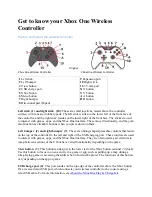
b.
Manually move the actuator to the full “open” position.
c.
Rotate Cam 7 (and Cams 9 & 11) counter-clockwise until
it engages the switch roller and the switch just “breaks”.
You should hear a light click.
d.
Tighten the setscrew on Cam 7.
e.
If auxiliary switches were provided, rotate Cams 9 & 11
about 2 degrees in the counter-clockwise direction. Then
tighten the setscrew. This will ensure that Switches 9 & 11
“makes” when the actuator reaches the full open position.
f.
If travel is not correct, repeat steps (a) through (e).
Close (clockwise) direction of travel:
a.
Loosen setscrew on Cam 2 (and Cams 4 & 6 for auxiliary
switches) to give the cam(s) a finger tight grip on the shaft.
Rotate cam(s) in a counter-clockwise direction away from
the switch.
b.
Manually move the actuator to the full “close” position.
c.
Rotate Cam 2 (and Cams 4 & 6) clockwise until it
engages the switch roller and the switch just “breaks”. You
should hear a light click.
d.
Tighten the setscrew on Cam 2.
e.
If auxiliary switches were provided, rotate Cams 4 & 6
about 2 degrees in the clockwise direction. Then tighten
the setscrew. This will ensure that Switches 4 & 6 “makes”
when the actuator reaches the full open position.
f.
If travel is not correct, repeat steps (a) through (e).
Replace the cover and tighten all flange bolts.
Replace manual handwheel, pin, washer and bolt.
The actuator is now ready for electrical operation.
Note: In the event that the above procedure does not give the
necessary travel control, the micro-adjustment cam must be
repositioned as follows:
To set the open (counter-clockwise) direction of travel by
adjusting the switch plate:
a.
Loosen Pivot and Micro-adjustment screws on the open
switch stack (switches 7, 9 and 11).
b.
If the actuator has not reached the full open position, rotate
the micro-adjustment cam to swing the switches outward
(away) from the cams.
c.
If the actuator has over-traveled, move the switch stack
inward (toward) the cams.
d.
Tighten pivot and micro-adjustment screws.
To set the close (clockwise) direction of travel by adjusting
the switch plate:
a.
Loosen Pivot and Micro-adjustment screws on the close
switch stack (switches 2, 4 and 6).
b.
If the actuator has not reached the full open position,
rotate the micro-adjustment cam to swing the switches
outward (away) from the cams.
c.
If the actuator has over-traveled, move the switch inward
(toward) the cams.
d.
Tighten pivot and micro-adjustment screws.
Replace the cover and tighten all flange bolts.
Replace manual handwheel, pin, washer and bolt.
The actuator is now ready for electrical operation.
Pivot Screw
7
2
Switch 6
Switch 4
Switch 11
Switch 7
Switch 9
Switch 2
Cam 6
Cam 11
Cam 9
Cam 2
Cam 7
Cam 4
6
Cam Adjustment–Groups 25 & 40:
MAR1600 & 4000–Part Turn Models
Cam & Stop adjustments (if required), as follows:
Open (counter-clockwise) direction of travel:
a.
Loosen setscrew on Cam 1 (and Cam 3 for auxiliary
switches) to give the cam(s) a finger tight grip on the shaft.
Rotate cam(s) in a counter-clockwise direction away from
the switch.
b.
Loosen both manual stop bolts on the worm gear
assembly by rotating both counter-clockwise 3 to 4 full
turns.
c.
Manually move the actuator to the full “open” (CCW)
position.
Open
(CCW)
Close
(CW)
Set Screw
CAUTION
To prevent ignition of hazardous atmospheres, do not
remove actuator cover while curcuits are live.
REQUEST A QUOTE AT WWW.AUTHORIZEDPARTS.COM


































